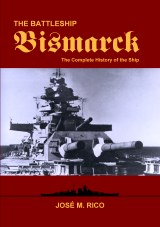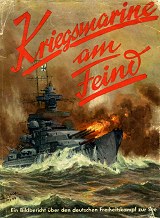High Command of the Wehrmacht [OKW],
Operations Staff (Kriegsmarine)
Minutes of the Conference regarding the Crimea held at Wolfsschanze on 27 October 1943.
| Present: |
Commander in Chief, Kriegsmarine, Großadmiral Dönitz The Reichsmarschall Göring Chief of the OKW, [Generalfeldmarschall Keitel] Chief of the OKW, Operations Staff [General Jodl] Chief of the Army General Staff, [General Zeitzler] Chief of the Seekriegsleitung, Operations Section OKW, Operations Staff (Kriegsmarine) Chief of the Luftwaffe General Staff [General Korten] Chief of Operations Division, Luftwaffe Staff [Oberst Christian] |
1. The Chief of the Army General Staff reports on the situation along the southern Front and in the Crimea. Großadmiral Dönitz comments on the naval coast artillery situation in the Crimea and the use that is being made of our naval forces in the Black Sea. At present approximately 8 S-boats, 12 motor minesweepers, 60 barges (MFP), and 6 naval artillery lighters (MAL) are in service in the Black Sea. Three of the submarines are in action, and one will be ready soon.
The Führer wants to know whether the submarines can be used in waters South of the Crimea to assist in preventing landings. Großadmiral Dönitz answers this question in the affirmative. Questioned as to the extent to which landings are possible in the Crimea, the Commander in Chief, Navy, states that, weather permitting, it is possible to land anywhere on the Kerch peninsula and along the southern coast of the Crimea.
In the long run it would be difficult to bring in supplies if the use of harbors were denied us. However, small bays could be made to serve the purpose for some time.
2. With a map of the Black Sea on hand, the Commander in Chief, Navy, explains the present status of the Russian Black Sea Fleet. He points out that the one battleship is not ready for action and that the cruisers have remained completely inactive thus far. Then he remarks on our own shipping space in the Black Sea, which amounts to about
-
9 steamships totaling 21,900 BRT
5 motor ships totaling 6,900 BRT
Referring to a possible evacuation of the Crimea, the Commander in Chief, Navy, mentions the following: Approximately 60 landing craft (MFP) are available, each capable of carrying about 200 to 300 men with light equipment. In winter their capacity averages no more than 200 men. Their capacity is dependent upon the weather. The distance from the West coast of the Crimea to Sulina is about 180 nautical miles. A trip to Sulina takes about one and one half days either way. In other words, about four days should be allowed for a round trip. The Commander in Chief, Navy, believes that we can count on perhaps 50 landing craft (MFP) in the event of an evacuation. These together can carry a total of approximately 10,000 men on each trip.
The weather, above all, will determine whether or not it is feasible to use sea-going lighters, which are towed at reduced speed. About 35 of these are in serviceable condition at this time. The Führer, however, does not believe he can count on these lighters. His conservative estimate is that only about 5 steamers and 50 landing craft (MFP) will be available for evacuation purposes. Since the Commander in Chief, Navy, believes he can guarantee that 2,000 men will be carried per steamer, each trip of the combined evacuation fleet would make possible the evacuation of 20,000 men with light gear. Thus 10 round trips would be necessary to effect the evacuation of 200,000 men.
The Reichsmarschall calls attention to the great agricultural importance of the Ukraine, urging strongly that the area be held. The Führer himself states that loss of the Crimea would greatly endanger the Rumanian oil fields. It is felt at this time that the arrival of strong reinforcements may yet restore the situation on the Southern Front.
3. The Commander in Chief, Navy, requests information concerning supply requirements in case the Crimea is cut off and must be treated as an island. The Führer expects that supplying the Crimea will follow the same pattern as was formerly used in defense of the Kuban bridgehead. The Chief of the Army General Staff does not consider the supply problem to be crucial at this time. Ammunition on hand will last 2 or 3 weeks; food until the middle of December. The Führer believes that available cargo space will assure sea-borne supplies in sufficient quantities, i.e. at least 50,000 tons per month. The Commander in Chief, Navy, hopes that a somewhat higher figure may be reached.
The Chief of the Army General Staff sets forth that a force of 10 divisions needs about 2,000 tons of supplies daily, or 60,000 tons per month. However there are large stores of food on the island proper which would not require transportation.
The Führer believes that it should be possible to restore the Southern Front with the help of the 8 divisions just transferred to that sector. This attempt must be made, since the Crimea is of the utmost strategic importance. But the attempt will be worthwhile only if the Crimea is actually held. The problem is rendered difficult by the fact that there are Rumanian, not German divisions in the Crimea. These troops have demonstrated repeatedly that they are poor fighters, if they fight at all. The Chief of the Army General Staff dwells on this point with particular emphasis, fearing a complete collapse of the Rumanian divisions in the event of a determined Russian landing. The Führer is much more concerned about an airborne landing which might present greater difficulties and might be harder to repel than a seaborne landing.
Basing his estimate on aerial reconnaissance the Chief of the Luftwaffe, Operations Division Staff, believes the following sea-going transportation to be available to the Russians:
-
Approximately 43 landing barges in the area North of the Taman Peninsula.
Approximately 63 landing barges in the area South of the Taman Peninsula, as far down as Gelendshik.
In addition about 26 to 30 steamers totaling approximately 90,000 tons in the area North of Tuapse.
4. The Führer again stresses the fact that an evacuation of the Crimea would most seriously endanger the Rumanian oil refineries and oil fields. For this reason the Crimea must be held as long as possible. An evacuation by land is out of the question. Adequate preparations for an evacuation by sea must be made no matter what happens. In other words all available shipping space, including small craft, must be mobilized to the fullest extent.
The Commander in Chief, Navy, promises full mobilization. He points out, however, that ship losses are possible, hence a system of replacing lost shipping space must get under way. He further explains that considerable time will be required for evacuation as well as for supplies. If bad weather and winter storms are taken into account, it will take about 80 days to evacuate 200,000 men. He stresses the fact that it will become very difficult to supply the Crimea once the Russian Air Force is in a position to attack our seaborne traffic from bases West of the Crimea, i.e. in the area East and Southeast of Kherson.
The rest of the discussion is concerned with the problem of providing reinforcements both for Field Marshal von Kleist's Army Group and for the Crimea. The Luftwaffe is directed to attempt destruction of as many enemy landing craft and as much shipping space as possible. The Führer, in any case, expects the main landing along the Kerch Strait.
Conclusions reached at the conference: If at all possible, an evacuation of the Crimea is to be avoided as long as there remains any chance of restoring the situation on the southern Front. Should an evacuation become unavoidable, it would have to be by sea. The necessary steps for mobilizing cargo space are to be taken regardless of what is going to happen, since this cargo space will be urgently needed either for supplying or for evacuating the peninsula. The Army and the Luftwaffe are to be reinforced with the greatest possible speed.
OKW,
Operations Staff, (Kriegsmarine)
Supplement to the Minutes of 27 October 1943.
Overall Views of the Commander in Chief, Navy: There should be no advanced outposts off the Balkan coast. The loss of such outposts entails grave political and military disadvantages, particularly with regard to Rumania. The westward advance of the Russians necessitates construction of defenses along the entire Rumanian coast. Loss of Crimea would bring the Russians 300 to 400 kms closer to the Rumanian oil fields. The Crimea is a key area for the defense of the Balkans.
The Crimea should not be abandoned as long as there remains any hope of getting the situation at the southern end of the eastern Front under control and of holding the area around Krivoi-Rog and Melitopol.
All preparations necessary for supplying the Crimea exclusively by sea must be made.
signed: Dönitz
countersigned: Korvettenkapitän Mejer

Copyright © 1998-2024 KBismarck.com


